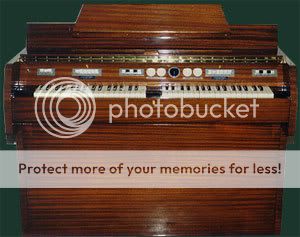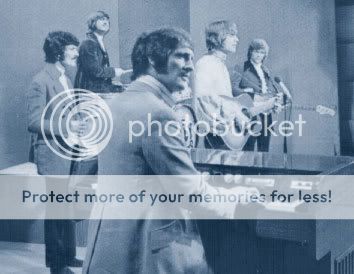The Mellotron
 The mellotron was probably the most unique instrument ever developed in the history of music. A more exact description of it would be an electromechanical polyphonic keyboard musical instrument. It was originally developed and built in Birmingham, England in the early 1960s. It was very similar to its ancester called the Chamberlin. It was developed by Harry Chamberlin in 1946. It had a piano- style keyboard. Underneath each key is a small tape deck. Each tape is pre-recorded with various musical instruments or special effects.
The mellotron was probably the most unique instrument ever developed in the history of music. A more exact description of it would be an electromechanical polyphonic keyboard musical instrument. It was originally developed and built in Birmingham, England in the early 1960s. It was very similar to its ancester called the Chamberlin. It was developed by Harry Chamberlin in 1946. It had a piano- style keyboard. Underneath each key is a small tape deck. Each tape is pre-recorded with various musical instruments or special effects.
When the player presses down on a key, the tape deck begins to play through an amplifeid speaker. When the player releases the key, the sound stops, and the tape rewinds. Each tape is only a few seconds long(about 8 seconds).
The earlier models (MKl, MKll), contained two side by side keyboards with 18 selectable sets of specially recorded sounds on the right keyboard, such as strings, flutes, and brass instruments, and pre-recorded accompaniment music in various styles on the left keyboard. The tape banks for the later models (M400) contain three selectable sounds for each changeable taperack, such as strings, cellos, and even an eight voice choir. The sound on each individual tape piece is recorded at the specific pitch of the key it was assigned to.
Mellotrons were normally pre-loaded with string instrument and orchestral sounds, although the tape bank could be removed easily by the owner and then loaded with different sounds including percussion loops, sound effects, or synthesizer-generated sounds.
Mellotrons were considered very precious because they enabled bands to perform brass, string, and choir arrangements that had previously been impossible to recreate live on stage.
Mellotrons were wonderful, but they also had their disadvantages. They were expensive, and they were hard to move because they were heavy, bulky, and very fragile. The worst was that the tape banks were very notoriously prone to breakages and jams, and those groups (The Moody Blues) that could afford to take their mellotrons on tour with them had to cope with these inevitable breakdowns.
Despite the disadvantages, Mellotrons were loved for their unique sound, and helped pave the way for more advancements.
The Mellotron can be heard on many rock albums; The Moody Blues; The Stones; The Beatles (Mike Pinder helped them use it) for the song, “Strawberry Fields”, King Crimson, and many other recording artists, too. But after hearing it on many recordings, I am still convinced that Mike Pinder really knew what to do with this thing. Not only did he play it so beautifully, but he was also involved with the technical development of it.
Mike Pinder playing the mellotron when he was with The Moody Blues

The Mellotron can be heard on Strawberry Fields
|
instrumentalpavilion wrote on Apr 3, ’08
What would have happened to prog without a mellotron? I lov the sounds of the Ondes Martenot as well (theremin cousin). Some of the new prog groups use mellotrons from time to time. The Birotron (created by Dave Biro with help from Rick Wakeman of Yes) was a tape replay thing that just failed gain any musical momentum with anyone. The monster used 8-track tapes.
|

Comments
The Mellotron — No Comments
HTML tags allowed in your comment: <a href="" title=""> <abbr title=""> <acronym title=""> <b> <blockquote cite=""> <cite> <code> <del datetime=""> <em> <i> <q cite=""> <s> <strike> <strong>